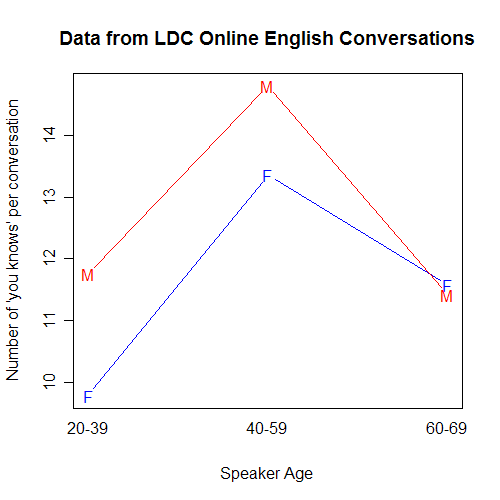December 30, 2007
You know
Matt Hutson writes:
My older sister used to be chastised by my parents for, like, saying "like" too much, when she was younger. Over Christmas, I realized how much she, you know, says "you know." I wonder if she simply replaced "like" with "you know" at some point many years ago. (She is an extrovert, by the way, perhaps hence not saying "I mean.")
Matt is following up on an earlier on-line conversation about personality, gender and filler phrases ("News flash: the biggest users of 'like totally' are middle-aged men", 8/18/2007; "I mean, you know", 8/19/2007 ).
I still don't know anything about possible correlations between personality types and choice of fillers; and I don't have anything helpful to say about possible trade-offs among fillers, though there's an interesting literature on functional similarities and differences in such phrases. But I can contribute a quick Breakfast Experiment™, based on LDC Online's collection of English Conversations, to show that there's general tendency for people to use "you know" somewhat more often in their middle years:
| Total conversational sides |
Total uses of "you know" |
Uses per side |
|
| 20-39 | 5,356 | 58,364 | 10.9 |
| 40-59 | 19,920 | 278,099 | 14.0 |
| 60+ | 2,908 | 33,477 | 11.5 |
The age categories are pretty crude, and not optimized to find differences in any particular variable, so a 28% increase between the "20-39" and "40-59" categories is striking. If we took the time to break out the age effect without grouping into pre-defined bins, the magnitude would probably be even greater.
Of course, Matt is talking about perception of individual differences, which might be very far from the group norms. But what he perceives as his sister's filler-phase trajectory is qualitatively congruent with the overall generational pattern, at least as shown in this apparent-time snapshot.
Interestingly, the general tendency of older women to talk more like younger men (see "Young men talk like old women", 11/6/2005; "Busy tongues", 12/31/2006; "What men and women blog about", 7/8/2007) is confirmed again in this case:

Here are the counts in tabular form:
Female |
Male |
|||||
| Total conversational sides |
Total uses of "you know" |
Uses per side |
Total conversational sides |
Total uses of "you know" |
Uses per side |
|
| 20-39 | 2,318 |
22,675 |
9.8 |
3,038 |
35,689 |
11.75 |
| 40-59 | 11,546 |
154,191 |
13.3 |
8,374 |
123,908 |
14.8 |
| 60-69 | 1,759 |
20,354 |
11.6 |
1,149 |
13,123 |
11.4 |
It seems to me that there's something going on here, in the effects of age and sex on linguistic variables, that's worth following up further. We've seen a similar general pattern in use of uh and um, where men use uh more than women, and older people use uh more than younger people, while men use um less than women, and older people use um less than younger people; in amount of talk, where males talk more than females, and older people talk more than younger people; in web-log vocabulary choice, where Schler et al. 2006 found that
Regardless of gender, writing style grows increasingly "male" with age ...
and now in the conversational frequency of you know.
This is reminiscent of the general tendency of the male/female opposition to line up sociolinguistically with informal/formal and lower-class/higher-class oppositions. For linguistic variables that are changing rapidly, we also expect to see male/female lining up with older/younger because women tend to lead most changes. However, it seems very unlikely that any of the variables discussed here are involved in such secular trends.
We might also connect this pattern with the general tendency in our culture, where feminine identity tends to be culturally marked (though biologically the default), and the degree of marking stereotypically decreases with age. But in the case of uh and um, the degree of gender differentiation seems to stay the same across age, although its effects change systematically in ways that see older women and younger men behaving similarly.
[Caveats: Other demographic variables (like education, and geographical region) are not necessarily balanced across sex and age classes in the data given above. And the differences by sex in number of you knows may be partly attributed to the small sex differences in word count per conversation -- see "Gabby guys: the effect size", 9/23/2006.
And as always, we're talking about modest group differences in overlapping distributions of individual characteristics, not qualitative differences in platonic archtypes -- though it remains difficult to find ways to talk and write that aren't misleading in this respect, and (perhaps therefore) deeply problematic for most of us to avoid sliding into conceptual confusion.]
Posted by Mark Liberman at December 30, 2007 10:19 AM